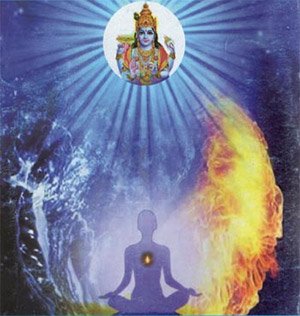Siddhanta Sangraha of Sri Sailacharya
by E. Sowmya Narayanan | 2008 | 30,562 words
Siddhanta Sangraha Chapter 17 (English translation), entitled “the concept of bhakti” as included in the critical edition and study. The Siddhanta Samgraha is a Sanskrit philosophical text dealing with Vishishtadvaita in five hundred Sanskrit verses. It was written by Shri Shailacarya (18th century) and closely follows the philosophy of Vedanta Deshika (13th century).
Chapter 17 - The Concept of Bhakti
162. It has been stated in the same way in the sacred works (śrī sūkti) of Śrī Vedānta Deśika that the prapatti never expects anything. A seeker of bhakti yoga has to learn the Vedas by rote with its six accessories and, on a superficial knowledge he tries to contemplate on the nature of the soul.
163. This helps him to claimb [climb] the ladder of bhakti yoga.[1] This means that the karma yoga and the jñana yoga serve as the limbs to bhakti yoga. By practicing the eight fold path of bhakti yoga (aṣṭāṅga yoga) the seeker attains the state of samādhi (Trance)
164. In the state of samādhi a seeker accomplishes a God like Vision. Thereby, he attains the Supreme Bliss.
165. Thus, by practicing bhakti yoga in accordance with one’s stage and state of life (varṇāśrama) till the fall of the physical body with the final remembrance of the Supreme (antimasmṛti). The antimasmṛti to the bhakta is possible only through the constant contemplation of the path of light (arcirādimārga), by which he can attain the mokṣa (liberation).
166. But for the followers of nyāsa (prapanna) the antimasmṛti is possible by the grace of the God Himself. He need not contemplate on the path of light. In the case of prapanna the result of the fructified actions come to an end as per his desire and the end of the physical body in which he is present.
167. Whereas in the case of the follower of bhakti yoga it is not so. It can happen only when the bhakti yoga niṣṭa who knows the true purpose of the incarnations of the Supreme coupled with bhakti yoga.[2]
168. Though bhakti yoga paved the way of destruction of prārabdha karma (fructified karma), always it should be practiced till the time of death. It is very necessary in the case of bhakti yoga. Therefore it is very difficult for us to follow. The bhakta may not get the liberation at the end of the present body for reaching the abode of the Supreme.
169. But in the case of prapanna, he will attain liberation or mokṣa immediately at the fall of the present body. The distinction and the intricacies of the bhakti and prapatti and the knowledge of the reality should be attained through spiritual teachers (acāryas) only.
Footnotes and references:
[1]:
See Yatīndra Mata Dīpikā, pp.87-89.
[2]:
Cf. Bhagavad Gītā, IV,9.
Conclusion:
 This concludes The Concept of Bhakti according to Vishishtadvaita philosophy explained by Shri Shailacarya. This book follows the model of Vedanta Deshika although the Vishishta Advaita school was originally expounded by Shri Ramanuja. Vishishta-Advaita is one of the various sub-schools of Vedanta which itself represents one of the six orthodox schools of Hindu Philosophy. They highlight the importance of the Upanishads, the Bhagavad Gita and the Brahma Sutras.
This concludes The Concept of Bhakti according to Vishishtadvaita philosophy explained by Shri Shailacarya. This book follows the model of Vedanta Deshika although the Vishishta Advaita school was originally expounded by Shri Ramanuja. Vishishta-Advaita is one of the various sub-schools of Vedanta which itself represents one of the six orthodox schools of Hindu Philosophy. They highlight the importance of the Upanishads, the Bhagavad Gita and the Brahma Sutras.
